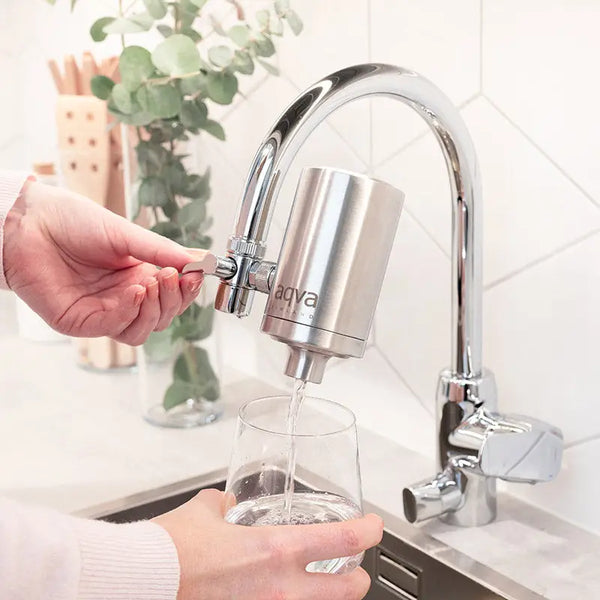Water is a fundamental element of life and crucial to maintaining health and well-being. This article delves into the diverse health benefits of water, examining its vital functions in bodily processes and overall health maintenance. We also explore the critical aspects of water quality, highlighting the importance of purity and the potential impacts of contaminants on human health. Furthermore, the article sheds light on the latest advancements in water purification techniques, offering insights into how these methods enhance water safety and quality.
Introduction
Water (H2O) is a remarkable natural element with unique properties arising from its molecular structure and organization, which allow it to exist in three distinct states: solid (ice), liquid (water) and gas (vapor). The uniqueness of water begins at the molecular level, where two hydrogen atoms form a covalent bond with one oxygen atom, creating a bent molecular structure. This structure results in a polar molecule with a slight positive charge on the hydrogen atoms and a slight negative charge on the oxygen atom, leading to hydrogen bonds between water molecules.(1-2) Water molecules also have many states of internal vibration and stretching, which basic quantum mechanics describes. The molecules form complex hydration structures in the presence of larger ions or colloids.(3)
In its liquid state, which is essential for all known life forms, water displays a dynamic network of hydrogen bonds. The bonds are constantly breaking and reforming, giving liquid water its fluidity. This molecular organization allows water to dissolve a wide range of substances ("universal solvent"), which is crucial for biological processes and ecosystems.(4)
As water freezes and turns into ice, the hydrogen bonds organize into a crystalline lattice that maintains a fixed distance between the molecules. This structure makes ice less dense than liquid water, a unique property among substances – ice floats on water.
The hydrogen bonds are predominantly broken in its gaseous state, water vapor, allowing water molecules to spread out and mix with air molecules. Water's ability to transition into vapor plays a critical role in Earth's climate and weather patterns, including the formation of clouds and precipitation.
EZ water, or Exclusion Zone water, is a fourth phase of water proposed by Dr. Gerald Pollack. It is characterized by unique properties such as higher density, viscosity and a negative electrical charge, which differ from standard water phases. This state occurs near hydrophilic surfaces, forming a structured water layer that excludes particles and solutes. Several groups have independently demonstrated the existence of the exclusion zone. However, many findings from Pollack's lab still need to be replicated by independent groups.(5)
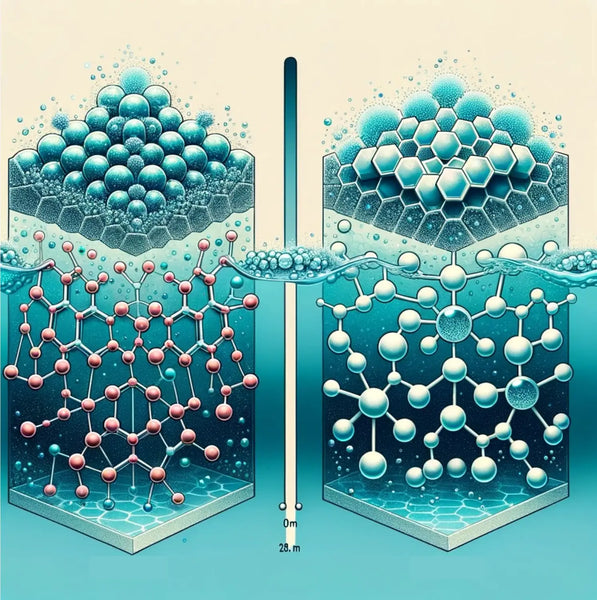
Image: An artistic interpretation of EZ water vs. bulk water.
On average, humans are composed of approximately 65% water, making it a fundamental component of our physiology. This high percentage emphasizes water's critical role in various bodily functions, from cellular homeostasis to organ system operations. Dehydration, even by a few percentage points, can significantly impair our general ability to function, affecting cognitive abilities, physical performance, and overall well-being. For instance, a mere 2% reduction in body water content can lead to noticeable decreases in mental and physical capabilities.(6)
Fluid balance regulation is one of our most important regulatory mechanisms for maintaining homeostasis. It involves complex processes such as osmoregulation, which controls the body's water and salt concentrations and is crucial for proper cellular function. The body's hydration status also directly influences blood volume, pressure and circulation, impacting heart health and the efficiency of nutrient and oxygen transport throughout the body. Additionally, water is critical in waste removal and detoxification processes, primarily through renal functions.(7-8)
Are we running out of freshwater?
Water is essential for life. Therefore, the significance of clean drinking water to health must be thoroughly considered.
The concern about depleting freshwater resources is becoming increasingly prominent in global discussions. Freshwater constitutes only a tiny fraction of the Earth's water supply. Rapid population growth and industrial and agricultural expansion have led to unprecedented stress on these limited resources. While the planet's total water volume remains constant, the availability of freshwater suitable for drinking, farming and industry is diminishing.
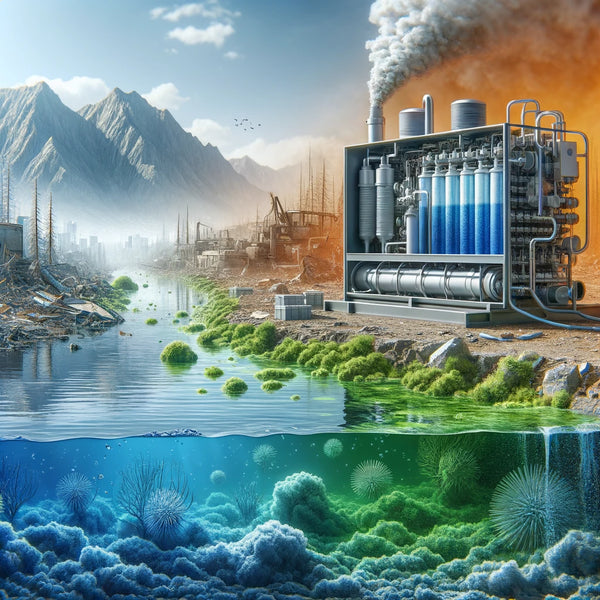
Climate change aggravates the situation by altering precipitation patterns, leading to droughts in some regions and floods in others, further impacting freshwater accessibility.
Fresh water is also a diminishing natural resource due to intensive farming, among other things. As much as 70 % of the world's water resources, including groundwater, are used in agriculture.(9) The United Nations has estimated that freshwater consumption has increased six-fold in the past century. If the raw water (groundwater) contains organic matter suitable as a source of impurities (surface water), impurities remain in the water even after disinfection.
Finland was one of the first countries to change its water purification systems when the adverse effects of trihalomethane, furans, and bromate became evident.(10)
When the disinfection method is the most common one (chlorination), various chlorinated compounds form as chlorine and organic matter react. Demographic studies have indicated that the long-term use of drinking water made from surface water through chlorination may increase cancer risk.(11) However, the advantages of chlorination outweigh the disadvantages.
Even 50+ year-old water pipes can leak impurities into the drinking water.(12) In some rural areas, tap water contains excess calcium, which can be a predisposing factor for coronary artery disease and heart attacks.(13) In drilled wells, a brown color and unpleasant odor may indicate high iron and manganese levels.(14)
Is Spring Water Any Better?
Spring water originates from underground sources and naturally flows to the surface. As it travels through underground rocks and substrates, it gets naturally filtered and absorbs minerals like calcium, magnesium and sodium. These minerals can alter the water's molecular organization slightly. For instance, ions from the minerals can interact with water molecules, affecting how they bond. The interaction can slightly change the physical properties of the water, such as taste and pH level.(15)
In contrast, still water in a bottle, especially if it is purified or distilled, might have fewer dissolved minerals and impurities. Purification processes like distillation or reverse osmosis remove contaminants and minerals, leading to water with fewer ions and a more straightforward molecular structure. The lack of additional minerals and ions means that the hydrogen bonding in bottled water is more typical of pure water, potentially making it less structured than mineral-rich spring water.
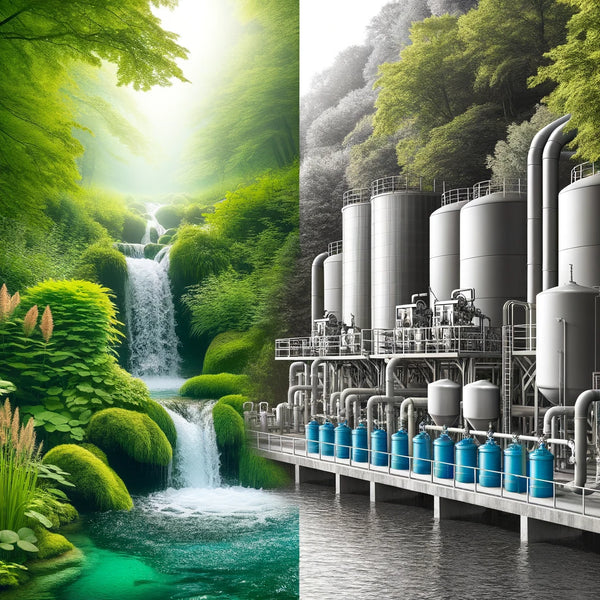
Table: Comparison of natural spring water vs tap water [16-20]
|
Feature |
Natural Spring Water |
Tap Water |
|
Source and Composition |
Emerges underground and naturally flows to the surface. As it travels through layers of rock and soil, it picks up various minerals like calcium, magnesium and potassium. These minerals contribute to the water's taste and interact with its molecular structure. The mineral content can enhance the formation of clusters of water molecules, slightly altering the water's properties. |
Sourced primarily from surface water (like rivers and lakes) or groundwater, tap water is treated in municipal plants to make it safe for drinking. The treatment includes filtration, often adding chlorine or chloramines for disinfection, and sometimes fluoridation for dental health benefits (luckily, this procedure is quite rare nowadays due to fluoride's toxic potential). Treatments can alter the water's molecular composition and structure. For instance, chlorine can interact with water molecules, changing the taste and potentially forming by-products.
|
|
Treatment and Purity |
Generally requires minimal treatment because it is often naturally filtered and free of many contaminants in surface water. However, it is not immune to pollution and can be contaminated by substances present in the environment. |
Undergoes rigorous treatment processes to remove contaminants pathogens, and adjust pH. While effective in making water safe, these processes can also strip away beneficial minerals, and residual disinfectants like chlorine can impact the water's taste and chemical composition. |
|
Taste and pH |
The mineral content in natural spring water often presents a distinct taste and can affect its pH, typically making it slightly alkaline. |
Depending on the treatment and local water source, tap water might have a neutral or slightly different pH and can sometimes have a slight chlorine taste due to disinfectants. |
|
Structural Differences |
While the basic molecular structure of water (H20) remains constant, the presence of minerals, gases, and other dissolved substances can cause subtle variations in how water molecules interact. In spring water, minerals can lead to a more complex molecular interaction. |
Tap water may have fewer interactions and disorganized structure, especially if heavily treated. |
Interestingly, Chinese older adults who depend on natural water for drinking from childhood to old age (65–79 years), using natural water unchangeably was associated with a significantly lower risk of all-cause mortality than those switching to tap water in later life. More studies and comprehensive causal analyses are needed to explore the association in different countries and populations.(21)
Recommendations for Water Consumption
Official guidelines recommend drinking a minimum of 1–1.5 liters (35–50 fl oz), preferably 2–3 liters (70–100 fl oz) of water per day. The water requirement increases with rising temperatures. The elderly should also drink more fluids due to the impaired ability of their kidneys to filter urine. The elusive daily water requirement for individuals is 1.8 L/24h, with 19-71% of adults in various countries consuming less than this intake, potentially increasing the risk of dysfunctional metabolism and chronic diseases.(22)
Exaggerated fluid intake during exercise is not recommended. Excessive hydration and its side effect of salt/ sodium loss (hyponatremia) may be more harmful than insufficient fluid intake. The daily water requirement is approximately 3.7 liters for men and 2.7 liters for women.(23) It is surprising how much water we get from food (particularly vegetables, fruits and berries with a high water content).
Store water in a dark glass bottle whenever possible. Avoid plastic as harmful compounds such as BPA or phthalates may dissolve in the liquid. These compounds are in plastic bottles marked with a recycling symbol with the number 03 or 07. They have a harmful effect on the functions of the endocrine system.(24)
Favor the following:
- Naturally flowing spring water (microbiologically tested)
- Liquid contained by plants (freshly squeezed juice, sap, coconut water)
- Drilled well water and well water
- Purified tap water (separate filtering device or filter attached to tap, see later in this article)
- Reverse osmosis (RO), activated carbon filtering, ion exchange
- High quality spring water or mineral water sold in glass bottles (such as Pellegrino)
Avoid the following:
- Water packaged in plastic bottles
- Vitamin-enriched water
- Flavored waters
- Externally carbonated water
- Unpurified (or regular) tap water (can be drinkable but is much better when filtrated)
Water Purification and Filtration Systems
Water purification and filtration make water safe for consumption and other uses. It removes unwanted substances, including physical impurities like dirt and debris, chemical contaminants such as pesticides and heavy metals, biological agents like bacteria and viruses, and radiological hazards. The choice of purification method depends on the nature of the water and the types of contaminants present (such as membran filtration, nanofiltration and chemical treatments).(25-27)
Physical contaminants primarily include sediment or organic material from soil erosion. These can affect water's taste, color and odor and may harbor microorganisms or chemical pollutants. Chemical contaminants are diverse, ranging from naturally occurring minerals to artificial chemicals like industrial waste products, pesticides, heavy metals and pharmaceutical residues. Some heavy metals, like lead or arsenic, pose significant health risks even at low concentrations.(28)
Biological contaminants consist of bacteria, viruses, protozoa, and parasites. These can cause diseases ranging from mild gastrointestinal discomfort to severe conditions like cholera or dysentery.(29)
Radiological contaminants, including uranium, radium and thorium, can naturally occur or result from industrial processes. Exposure to certain levels of these contaminants can lead to increased cancer risk and other health problems, such as neurological issues (neurotoxicity).(30)
Water Filtration Techniques:
- Mechanical filtration physically traps particles using a filter media. Filters with smaller pores can trap finer particles but may require more frequent maintenance due to clogging.
- Activated carbon filters effectively remove organic compounds and chlorine, improving water taste and smell. The adsorption process in these filters also removes certain pesticides and industrial chemicals.
- Reverse osmosis is one of the most comprehensive filtration methods, capable of removing most contaminants, including dissolved salts and metals. It forces water through a semipermeable membrane, leaving impurities behind.(31)
-
Ion exchange filters are especially useful in softening water by removing calcium and magnesium ions, which cause hardness. They replace calcium/magnesium ions with sodium or hydrogen ions. The ion-exchange method effectively removes heavy metal ions from water and industrial wastewater, reducing environmental contamination and enabling efficient removal of impurities.
(32) - UV filtration utilizes ultraviolet light to disinfect water, effectively destroying bacteria, viruses and other pathogens without adding chemicals or changing the water's taste or odor.(33)
Water Purification Systems for Consumers:
- Pitcher filters are a convenient and affordable option for improving the taste and quality of tap water. They typically use activated carbon filters to reduce chlorine and other common contaminants.
- Faucet-mounted filters provide a more direct solution for purified water straight from the tap. They are easy to install and effectively reduce a wide range of contaminants.
When selecting a water purification system, it is crucial to consider the household's specific water quality needs. Testing water for contaminants can help determine the most suitable type of filtration. Certifications from organizations like NSF International or the Water Quality Association can ensure a system's effectiveness in reducing specific contaminants.
Emerging Technologies in Water Purification:
- Nanotechnology: Use of nano-materials for more efficient contaminant removal (like micro- and nanoplastics).(34)
- Advanced Oxidation Processes: Innovative methods for breaking down organic pollutants.(35)
- Smart Water Purification: Systems with sensors and IoT technology for monitoring water quality and filter life.(36)
Benefits of Purified Water
Consuming purified water significantly reduces the risk of contracting diseases caused by waterborne pathogens such as bacteria, viruses, and protozoans. It also minimizes exposure to harmful chemical contaminants like lead, mercury, and pesticides, which can have long-term health effects, including neurological disorders, reproductive issues and increased cancer risk.(37-38)
Purification processes like activated carbon filtration remove substances that affect the taste and smell of water, such as chlorine and sulfur compounds. This results in water that is more appealing to drink, which can encourage better hydration habits.
How the AQVA ULTRA 2 tap water filter works:
- Large debris and sediments are filtered out of the water on the outer surface of the filter.
- The activated carbon absorbs several water impurities, and the ion exchange works effectively against several metals and heavy metals.
- Ultrafiltration filters bacteria, yeasts, protozoa, and micro debris, including microplastics, down to 0.1 micrometers.
Unlike some bottled mineral waters, purified water generally does not contain high salts and minerals that might interfere with the body's nutrient absorption and balance if one does not have them from the diet. Therefore, it may be wise to use electrolytes in purified drinking water.
Water Structuring and Structured Water – Hype or Hope?
Water structuring is the organization and behavior of water molecules in a definite, orderly pattern or form. Due to water's unique molecular structure, this idea has become very popular in biology and alternative medicine.
Water molecules are polar molecules with one oxygen atom bonded to two hydrogen atoms. The oxygen end is weakly negative and the hydrogen end is weakly positive; thus, a dipole moment is created. The polarity enables water molecules to hydrogen bond with each other, which is necessary for its structuring.(39)
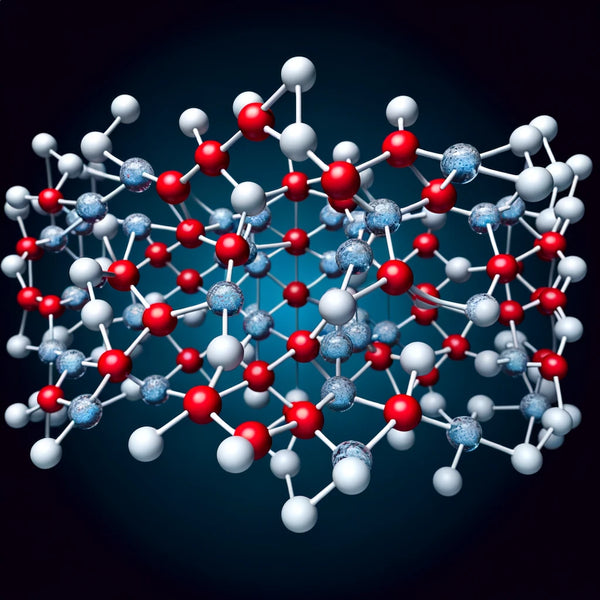
Temperature and pressure are other environmental factors that impact water's molecular organization. For example, colder temperatures lead to a more structured form of water (like ice), where hydrogen bonds create a fixed, crystalline structure. These bonds are more easily broken in warmer conditions, giving the water its fluidity (the elements of water are explained at the beginning of the article).
Additionally, the presence of contaminants or additives can affect water's structure. For instance, chemicals like chlorine, often added to tap water for purification (see before), can interact with water molecules and alter the overall molecular interaction.
Thus, the source and treatment of water, along with environmental conditions like temperature and pressure, play a crucial role in determining its molecular organization and structure.
In living systems, water is seldom simply a solution of scattered molecules. It has a structuring, more particularly in cellular environments. For instance, water in cell membranes, proteins, DNA and water around these structures displays a different structure than bulk water (drinking water delivered to consumers by means other than pipeline or bottled water). This structuring is essential in many biological processes, such as enzyme operation and cell communication.(40-41)
There are many techniques and technologies promoted as water structuring that claim a wide range of healthful effects as well as physical changes. These may be magnetic or vortex treatment, exposure to particular sound frequencies or water passing through mineral compositions.(42)
Although water structuring in biological organisms is a well-established phenomenon, the effect of artificially structured water on health or its properties needs to be elucidated and requires a more robust scientific validation.(43)
Conclusion
To summarize, the importance of water purification and filtration for enhancing the quality and safety of our drinking water is evident. Understanding the technologies and systems available allows consumers to select the most effective solutions. Purified water reduces the risks associated with various contaminants and significantly improves the taste and overall quality of the water we drink. This also holds for already water treatment plant-purified water, as water pipes and the chemicals used in the purification process can leave tap water inferior or suboptimal for human consumption.
As we explore the options for water treatment, from simple carbon filters to advanced reverse osmosis systems, the health benefits become increasingly apparent. Making an informed choice about water purification can lead to better overall health, ensuring that the water we consume is as beneficial and safe as possible.
The advancements in water purification technology continue to evolve, offering even more efficient and effective ways to enhance our drinking water. By staying informed and choosing the proper purification methods, we can ensure that our daily water intake contributes positively to our health and well-being.
Scientific references:
- Geiger, A. & Mausbach, P. (1991). Molecular dynamics simulation studies of the hydrogen bond network in water. In Hydrogen-Bonded Liquids (pp. 171-183). Dordrecht: Springer Netherlands.
- Brini, E. et al. (2017). How water’s properties are encoded in its molecular structure and energies. Chemical Reviews 117 (19): 12385–12414.
- Ojha, D. & Henao, A. & Kühne, T. (2018). Nuclear quantum effects on the vibrational dynamics of liquid water. The Journal of Chemical Physics 148 (10): 102328.
- Fernández-Serra, M. & Artacho, E. (2006). Electrons and hydrogen-bond connectivity in liquid water. Physical Review Letters 96 (1): 016404.
- Elton, D. & Spencer, P. & Riches, J. & Williams, E. (2020). Exclusion zone phenomena in water—A critical review of experimental findings and theories. International Journal of Molecular Sciences 21 (14): 5041.
- Szinnai, G. & Schachinger, H. & Arnaud, M. & Linder, L. & Keller, U. (2005). Effect of water deprivation on cognitive-motor performance in healthy men and women. American Journal of Physiology-Regulatory, Integrative and Comparative Physiology 289 (1): R275–R280.
- Noda, M. & Matsuda, T. (2022). Central regulation of body fluid homeostasis. Proceedings of the Japan Academy, Series B 98 (7): 283–324.
- Danziger, J. & Zeidel, M. L. (2015). Osmotic homeostasis. Clinical Journal of the American Society of Nephrology 10 (5): 852–862.
- Gleeson, T. & Wada, Y. & Bierkens, M. & van Beek, L. (2012). Water balance of global aquifers revealed by groundwater footprint. Nature 488 (7410): 197–200.
- World Water Assessment Programme. (2003). Water for People, Water for Life. The United Nations World Water Development Report. UNESCO.
- Hakulinen, P. (2006). Experimental studies on cellular mechanisms of the carcinogenicity of 3-chloro-4-(dichloromethyl)-5-hydroxy-2(5H)-furanone (MX). Doctors thesis, KTL.
- Galarce, C. & Fischer, D. & Díez, B. & Vargas, I. & Pizarro, G. (2020). Dynamics of biocorrosion in copper pipes under actual drinking water conditions. Water 12 (4): 1036.
- Kousa, A. et al. (2006). Calcium:magnesium ratio in local groundwater and incidence of acute myocardial infarction among males in rural Finland. Environmental Health Perspectives 114 (5): 730–734.
- Qin, S. & Ma, F. & Huang, P. & Yang, J. (2009). Fe (II) and Mn (II) removal from drilled well water: A case study from a biological treatment unit in Harbin. Desalination 245 (1-3): 183–193.
- Kresic, N. (2010). Types and classifications of springs. In Groundwater hydrology of springs (pp. 31-85). Butterworth-Heinemann.
- Quattrini, S. & Pampaloni, B. & Brandi, M. (2016). Natural mineral waters: chemical characteristics and health effects. Clinical Cases in Mineral and Bone Metabolism 13 (3): 173–180.
- Sullivan, M. & Leavey, S. (2011). Heavy metals in bottled natural spring water. Journal of Environmental Health 73 (10): 8-13.
- Park, S. et al. (2023). Perceptions of Water Safety and Tap Water Taste and Their Associations With Beverage Intake Among US Adults. American Journal of Health Promotion 37 (5): 625–637.
- Dąbrowska, A. & Nawrocki, J. (2009). Controversies about the occurrence of chloral hydrate in drinking water. Water Research 43 (8): 2201–2208.
- Honig, V. & Procházka, P. & Obergruber, M. & Roubík, H. (2020). Nutrient effect on the taste of mineral waters: Evidence from Europe. Foods 9 (12): 1875.
- Liu, L. et al. (2022). Drinking natural water unchangeably is associated with reduced all-cause mortality in elderly people: A longitudinal prospective study from China. Frontiers in Public Health 10: 981782.
- Armstrong, L. & Johnson, E. (2018). Water intake, water balance, and the elusive daily water requirement. Nutrients 10 (12): 1928.
- Sawka, M. & Cheuvront, S. & Carter, R. (2005). Human water needs. Nutrition Reviews 63 (Suppl_1): S30–S39.
- Wagner, M. & Oehlmann, J. (2009). Endocrine disruptors in bottled mineral water: total estrogenic burden and migration from plastic bottles. Environmental Science and Pollution Research 16 (3): 278–286.
- Rastogi, R. (2019). Water Purification Using Different Chemical Treatment. In Handbook of Research on the Adverse Effects of Pesticide Pollution in Aquatic Ecosystems (pp. 338-367). IGI Global.
- Bolong, N. & Ismail, A. & Salim, M. & Matsuura, T. (2009). A review of the effects of emerging contaminants in wastewater and options for their removal. Desalination 239 (1-3): 229–246.
- Cevallos-Mendoza, J. & Amorim, C. & Rodríguez-Díaz, J. & Montenegro, M. (2022). Removal of contaminants from water by membrane filtration: a review. Membranes 12 (6): 570.
- Hopenhayn, C. (2006). Arsenic in drinking water: impact on human health. Elements 2 (2): 103–107.
- Okafor, N. & Okafor, N. (2011). Disease transmission in water. Environmental Microbiology of Aquatic and Waste Systems 189–214. Springer, Dordrecht.
- Canu, I. & Laurent, O. & Pires, N. & Laurier, D. & Dublineau, I. (2011). Health effects of naturally radioactive water ingestion: the need for enhanced studies. Environmental health Perspectives 119 (12): 1676–1680.
- Gupta, V. & Ali, I. (2013). Water treatment by reverse osmosis method. Environmental Water 117–134. Elsevier.
- Da̧browski, A. & Hubicki, Z. & Podkościelny, P. & Robens, E. (2004). Selective removal of the heavy metal ions from waters and industrial wastewaters by ion-exchange method. Chemosphere 56 (2): 91-106.
- Song, K. & Mohseni, M.,& Taghipour, F. (2016). Application of ultraviolet light-emitting diodes (UV-LEDs) for water disinfection: A review. Water Research 94: 341–349.
- Kumar, S. (2023). Smart and innovative nanotechnology applications for water purification. Hybrid Advances 100044.
- Oturan, M. & Aaron, J. (2014). Advanced oxidation processes in water/wastewater treatment: principles and applications. A review. Critical Reviews in Environmental Science and Technology 44 (23): 2577–2641.
- Li, J. & Yang, X. & Sitzenfrei, R. (2020). Rethinking the framework of smart water system: A review. Water 12 (2): 412.
- Payment, P. (2003). Health effects of water consumption and water quality. Handbook of Water and Wastewater Microbiology 209–219. Elsevier.
- Cantor, K. (1997). Drinking water and cancer. Cancer Causes & Control 8: 292–308.
- Stillinger, F. & David, C. (1978). Polarization model for water and its ionic dissociation products. The Journal of Chemical Physics 69 (4): 1473–1484.
- Watterson, J. (1988). The role of water in cell architecture. Molecular and Cellular Biochemistry 79: 101–105.
- Szolnoki, Z. (2007). A dynamically changing intracellular water network serves as a universal regulator of the cell: the water-governed cycle. Biochemical and Biophysical Research Communications 357 (2): 331–334.
- Lindinger, M. (2021). Structured water: effects on animals. Journal of Animal Science 99 (5): skab063.
- Korotkov, K. (2019). Study of structured water and its biological effects. International Journal of Complementary and Alternative Medicine 12 (5): 168–172.





